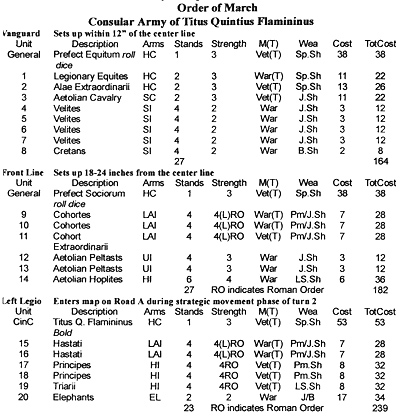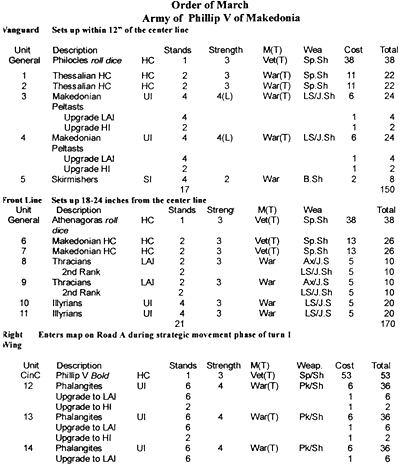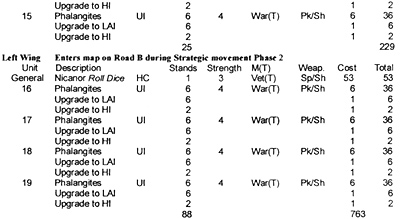



(Reminder) Roman Order (Version 5.0 by Terry Gore)
- Roman Order is a formation allowed to Roman HI. The HI may replace in combat any other Roman HI unit without becoming disordered by the interpenetration.
- Any Roman Heavy Infantry unit in good order is assumed to be able to use Roman Order (this includes Italian HI allies).
- Any Roman unit in Roman Order with an Advance order may move through and replace another Roman HI unit that is involved in a close combat without becoming disordered by the ensuing interpenetration, if it has sufficient movement to contact the involved enemy unit. This is assumed to take place during a lull in the actual fighting.
- The unit being replaced will be turned around 180 degrees and will end up 1" behind the Roman Order unit that advanced through it, facing the rear.
- The replaced unit must take a morale test immediately after this movement is finished to determine whether or not it is disordered by doing this. A simple unmodified morale roll, the same as rolling for frenzy, determines the result. Any failure to pass results in the replaced unit becoming disordered. There is no penalty to the Roman unit advancing through it into contact
- The fresh Roman HI will not count as charging but will count weapon factors as the initial round of a close combat, which it is to them.
- The enemy unit that is contacted by the fresh, advancing Roman unit will count weaponry as an initial close combat into a fresh enemy, but otherwise receive no other combat bonus for follow-up, etc. If frenzied, it will still receive the bonus for being frenzied in the initial round of close combat.
- The replaced unit may be turned 180 degrees to face at the beginning of the next turn with no penalty as per normal.
This Formation rule addresses several concerns. Having to give the Roman Order unit an Advance order puts a strain on the orders capability of the Roman command. By not having this count as a charge, but simply as an advance into combat, the Roman unit gets the benefit of fighting fresh with full ranks of pilum-armed HI in an initial round of close combat, but does not get a charge combat bonus. This simulates the gradual replacement of ranks, assumed to occur during lulls in the hand to hand fighting. The enemy unit will also be considered to be involved in an initial round of a close combat, but due to the gradual process of exchanging of ranks, will receive no follow-up move or bonus. Here is the real advantage to the Roman player, being able to bring fresh troops in to save a bad situation. There is also the chance that the replaced unit will pick up another disorder and possibly be in bad enough shape to rout (if it already was fragmented before the exchange of ranks. You take your chances with this, as with most other things in AW/MW.
Sources
Berg, Richard, and Mark Herman. SPQR: 2nd Edition Great Battles of History Series. GMT Games. 1996. Cardboard and paper wargame. This game is a great source for OoB information for Cynoscephalae. Berg and Herman are skilled designers and thorough researchers. Currently, it is out of print, but GMT may reprint it if the demand is high enough.
Livy. Rome and the Mediterranean, Books XXXI-XLV of the History of Rome from its Foundation, translated by Henry Bettenson, Penguin Books, 1976.
Introduction and Scenario Rules
Back to Saga # 91 Table of Contents
Back to Saga List of Issues
Back to MagWeb Master Magazine List
© Copyright 2003 by Terry Gore
This article appears in MagWeb.com (Magazine Web) on the Internet World Wide Web.
Other articles from military history and related magazines are available at http://www.magweb.com